Tenmangu Shrine is a shrine dedicated to Sugawara no Michizane, the deity of learning (commonly referred as Tenjin-sama). Kitano-tenmangu Shrine is the head shrine of approximately 12,000 Tenmangu Shrines and Tenjin Shrines nationwide.
Due to Sugawara no Michizane as the god of learning, Kitano Tenmangu Shrine is believed to bestow blessings for academic success and achievement.
Cow and Tenjin-sama

Within the grounds of Kitano Tenmangu Shrine, you will come across many statues of cows. Cows are considered to be messengers of Tenjin-sama. In Japan, there is a cultural tradition of using 12 animals to represent each year, and the year of Sugawara no Michizane's birth is symbolized by the cow.
You may notice that the cows at the shrine are seated. This originates from a legend stating that Sugawara no Michizane left a testament instructing that he be buried where a cow had sat. The cow statues within the precincts are called “Nade Ushi”, meaning “stroking cows”, and it is believed that stroking them can make wishes come true. For example, if someone wishes to become more intelligent, they might stroke the head of the cow, or if they have issues with their legs, they might stroke the legs. Visitors stroke the part of the cow corresponding to the improvement they desire.
Despite most cows being seated, at Kitano Tenmangu Shrine, you can see one standing cow in the main shrine. The reason for this is shrouded in mystery and is passed down as one of the seven wonders of Tenjin-sama.
Main Hall
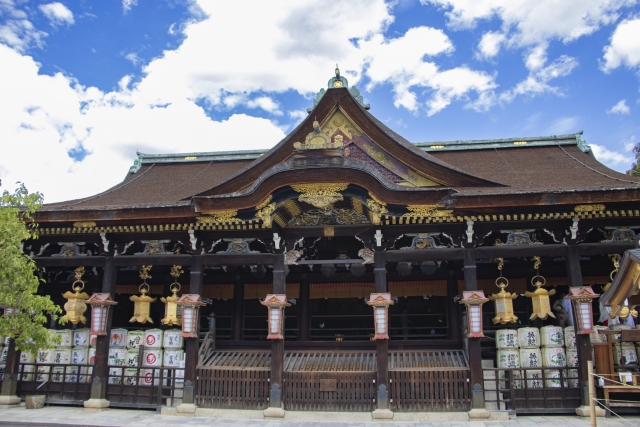
The main hall of Kitano Tenmangu Shrine, designated as a national treasure, covers an approximate area of 1,600 square meters. Its roof is constructed using an ancient Japanese construction technique with cypress bark. Adorned with numerous golden decorations and carvings, it exudes opulence and splendor. Built in 1607, it is exceptionally rare to find it preserved in its original scale from that time.
Within Kitano Tenmangu Shrine, there are many plum trees, and the plum tree in front of the main hall is known as the "Flying Plum". It is the only plum tree allowed to be planted in front of the divine altar. According to legend, when Sugawara no Michizane was exiled to Dazaifu (present-day Fukuoka Prefecture), the plum tree that admired him flew from Kyoto to Dazaifu. It is said that the plum tree in front of the main hall is a descendant of that Flying Plum.
Sankomon
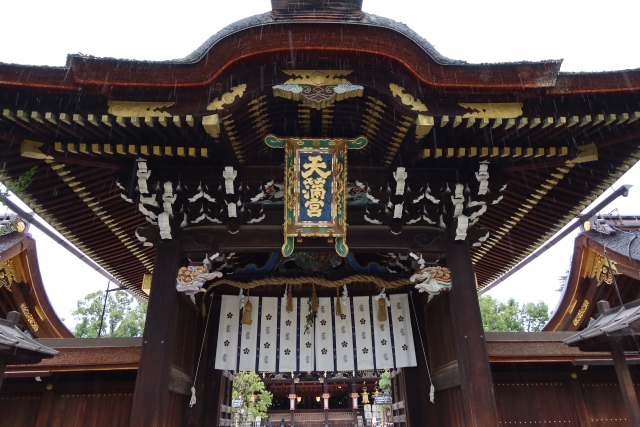
The Sankomon, located in front of the main hall, is a middle gate and is known as a symbolic structure of Kitano Tenmangu Shrine. "Sanko" means three lights, representing the sun, moon, and stars. Carvings of the sun and moon are engraved between the beams, but there is no carving of the stars. The reason for this is said to be that, from the location where the emperor once resided, the North Star shone directly above the Sanko-mon, explaining the absence of a star carving.
Plum garden
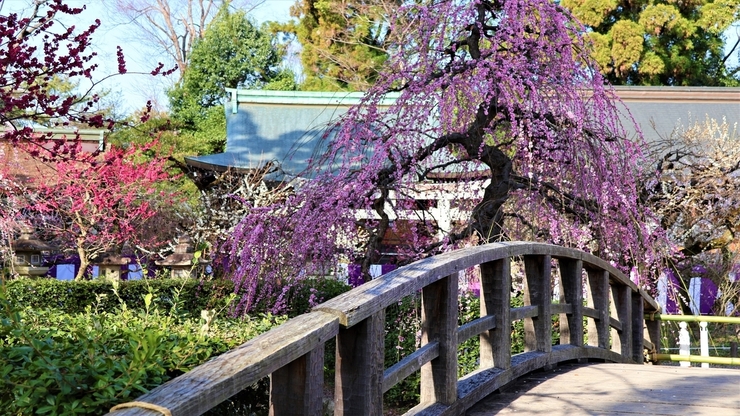
Kitano Tenmangu Shrine is a famous spot for plum blossoms that is associated with Sugawara no Michizane.
Before being unjustly punished and demoted, Sugawara no Michizane composed a waka (a traditional Japanese poem) with the theme of plum blossoms.
Approximately 1,500 plum trees of 50 varieties are planted on the property, and the red and white plum blossoms bloom from February to March.
Depending on the blooming situation, the plum garden may be open to the public, so please visit if you have the chance.
Plum garden
Entrance fee: 1200 yen for adults, 600 yen for children
Maple Garden
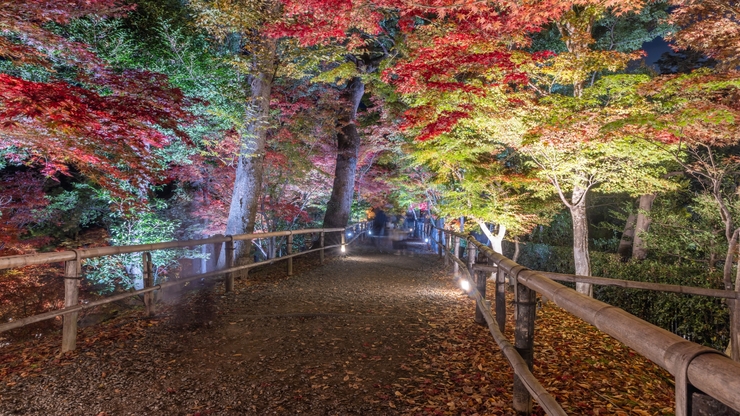
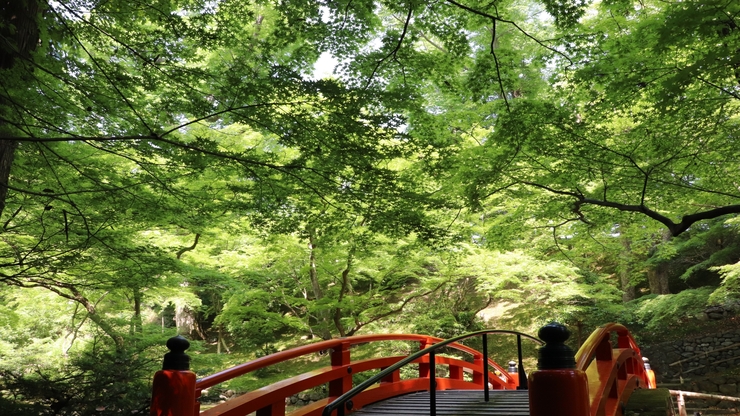
Kitano Tenmangu Shrine is famous for its plum blossoms, but it's also renowned for autumn foliage. In the Maple Garden, open from late October to early December, you can enjoy the sight of around 350 maple trees. Additionally, the garden showcases green maple leaves from mid-April to late June. The vermilion-painted drum bridge Uguisu-bashi, spanning over the Kamiya River, and the view from the stage overlooking the shrine grounds are exceptionally beautiful. Both the autumn foliage and green maple leaves are illuminated for a limited time. Please check the official website for the specific schedule, as it varies each year.
Maple Garden (late October - early December)
Entrance fee: 1,200 yen for adults, 600 yen for children
Green maple leaves (mid April - late June)
Entrance fee: 500 yen for adults, 250 yen for children
Tenjin Market
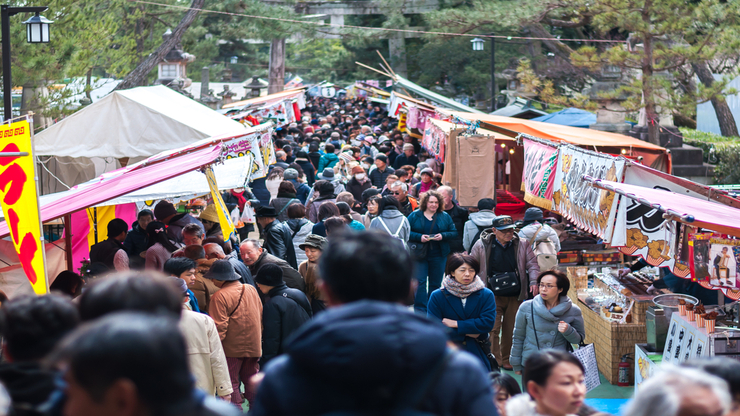
Tenjin Market is held on the 25th of every month at Kitano Tenmangu Shrine, and attracts a large crowd of about 1,500 stalls from early morning until around sunset. Various items, ranging from Japanese street foods like takoyaki and yakisoba to antiques and second-hand kimonos, are sold. There are many unique and unusual items available, making it enjoyable to simply stroll around and explore. The festival is held on the 25th of every month because Sugawara Michizane's birthday is June 25 and the anniversary of his death is February 25. Especially in January and December, the scale of the festival is significant, attracting around 150,000 visitors.
Treasure Hall
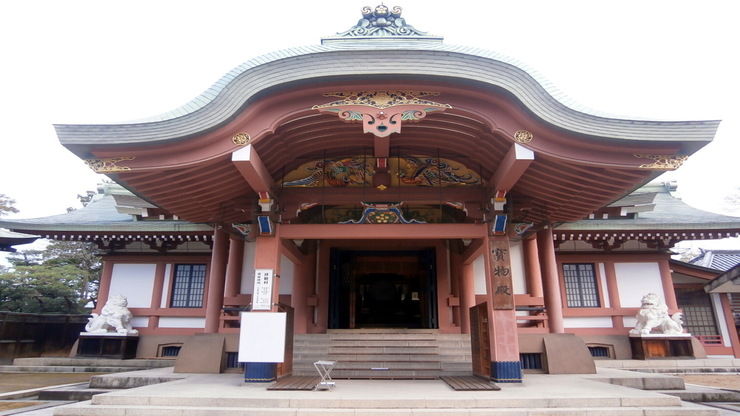
The Treasure Hall houses a vast collection of artistically valuable crafts such as ancient documents, paintings, swords, and tea utensils. The most renowned item is the "Kitano Tenjin Engi Emaki - Zhōkyūbon", designated as a national treasure. This scroll depicts various anecdotes and legends from the life of Sugawara no Michizane to his enshrinement as a deity at Kitano Tenmangu Shrine.
Opening Hours
It depends on the day.
Please refer to this official website
Admission Fee
Free (excluding special exhibitions).
Access
Address
Bakuro-cho, Kamigyo-ku, Kyoto-shi, Kyoto
Other Articles

To-ji Temple
To-ji temple (East Temple) was entrusted to the monk Kukai (Kobo Daishi), who studied Esoteric Buddhism. In addition to the five-story pagoda, there are many other attractions such as the Kondo Hall, Kodo Hall, and the Miedo Hall. To-ji temple is renowned for its beautiful autumn foliage and cherry blossoms. Additionally, the Kobo market (Kobo-ichi) is held on the 21st of every month.
Fushimi Inari Shrine

